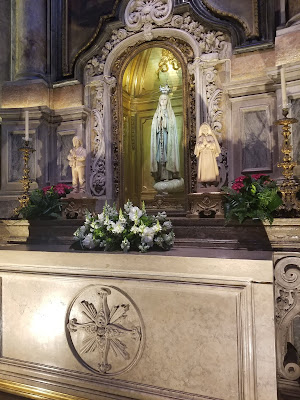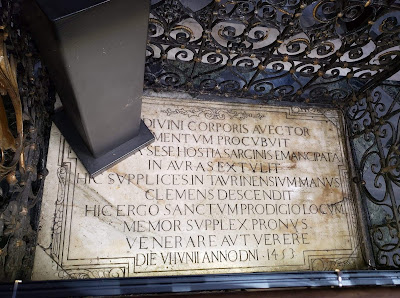When you think of beautiful testaments to the Catholic Faith of Europe, you are likely to think of the great and majestic churches of Paris, Chartres, Rome, or Florence. You may also think of the cathedrals and monasteries of Spain, the royal chapels and domed churches of Vienna, or the many churches that dot the Bavarian countryside in southern Germany. Yet, often not on the top of many lists, Portugal remains a largely Catholic country. Despite the atheistic government of the early 20th century which sought to repress the Catholic religion, the Virgin Mary appeared there in the town of Fatima in 1917 and worked a verifiable miracle seen by over 70,000 people. And despite the growing secularism of Europe, in which Portugal is not immune, the city of Lisbon remains home to many beautiful testaments of the Catholic and Apostolic Faith founded by our Lord Jesus Christ Himself.
I was privileged to visit Lisbon a few weeks ago and visit several dozen churches in Lisbon, in addition to Fatima. Here are my Top 10 Churches in Lisbon to visit and pray in.
Jerónimos Monastery
Jerónimos Monastery is arguably the most beautiful church in all of Lisbon. It is one of the top ones and inside you can see the tomb of the great Portuguese explorer, Vasco de Gama. The Church includes beautiful side altars and is a UNESCO World Heritage site. It was formerly part of the Order of St. Jerome before it was secularized by state decree in 1833. Mass is still offered in the church. It is located on the western side of Lisbon is the one furthest away from the city center but it is an absolute must-see.
Church of Saint Anthony of Lisbon
While he is almost universally invoked under the name of St. Anthony of Padua, St. Anthony is to the people of Lisbon still one of their own. St. Anthony (1195 - 1231) was born on August 15, 1195, in Lisbon, Portugal to Martin and Mary Bulhom. He was given the name of Fernando. In fact, he lived in Lisbon most of his life. While his family wanted him to become a great nobleman, he followed the call of Christ and became a poor Franciscan priest taking the name of Anthony. He lived his life in holiness curing many. After his death, he was canonized 352 days after his death, the second fastest canonization in history, with over 50 documented miracles.
Pilgrims may visit the Church of St. Anthony, which is located right next to the main Cathedral (Se Cathedral) in the historic Alfama district of Lisbon. Make sure you see the side altar which contains the relics of Justina of Padua who was a 4th-century martyr. Finally, don't neglect to go down to the crypt to pray before the exact spot where St. Anthony was born.
Monastery of St. Vincent Outside the Walls
St. Vincent the Deacon is the actual patron saint of Lisbon. In addition to a nice statue of their patron, who is holding a ship, the symbol of the city and the country, not far from the Church of St. Anthony is the impressive Monastery of St. Vincent Outside the Walls. While the inside is less ornate than the Jerónimos Monastery, it is a large and impressive building dedicated to a saint we often hear little about, even though he is one of the illustrious 7 deacons of the Early Church.
Church of St. Madelena
Igreja de São Nicolau
Church of Sao Roque
Cardaes Convent
Conclusion
In addition to these churches, Lisbon is home to an ancient castle, many wonderful restaurants, and scenic views. It is well worth the visit but if you do visit, please visit some of these wonderful testaments of the Catholic Faith and pray for the people of Portugal to return in greater numbers to regular attendance at Mass and reception of the Sacraments.
Did you find value in this post? Please consider making a donation to this blog via the sidebar's donation button.
Read more >>
I was privileged to visit Lisbon a few weeks ago and visit several dozen churches in Lisbon, in addition to Fatima. Here are my Top 10 Churches in Lisbon to visit and pray in.
Jerónimos Monastery
Jerónimos Monastery is arguably the most beautiful church in all of Lisbon. It is one of the top ones and inside you can see the tomb of the great Portuguese explorer, Vasco de Gama. The Church includes beautiful side altars and is a UNESCO World Heritage site. It was formerly part of the Order of St. Jerome before it was secularized by state decree in 1833. Mass is still offered in the church. It is located on the western side of Lisbon is the one furthest away from the city center but it is an absolute must-see.
Church of Saint Anthony of Lisbon
While he is almost universally invoked under the name of St. Anthony of Padua, St. Anthony is to the people of Lisbon still one of their own. St. Anthony (1195 - 1231) was born on August 15, 1195, in Lisbon, Portugal to Martin and Mary Bulhom. He was given the name of Fernando. In fact, he lived in Lisbon most of his life. While his family wanted him to become a great nobleman, he followed the call of Christ and became a poor Franciscan priest taking the name of Anthony. He lived his life in holiness curing many. After his death, he was canonized 352 days after his death, the second fastest canonization in history, with over 50 documented miracles.
Pilgrims may visit the Church of St. Anthony, which is located right next to the main Cathedral (Se Cathedral) in the historic Alfama district of Lisbon. Make sure you see the side altar which contains the relics of Justina of Padua who was a 4th-century martyr. Finally, don't neglect to go down to the crypt to pray before the exact spot where St. Anthony was born.
St. Justina is Venice's second patron saint. Who is the actual patron saint of Lisbon? It's actually not St. Anthony, although he is unofficially invoked as a patron. In fact, few Lisbonians know the city's actual patron. Who is the patron? For that, we will visit our next church...
St. Vincent the Deacon is the actual patron saint of Lisbon. In addition to a nice statue of their patron, who is holding a ship, the symbol of the city and the country, not far from the Church of St. Anthony is the impressive Monastery of St. Vincent Outside the Walls. While the inside is less ornate than the Jerónimos Monastery, it is a large and impressive building dedicated to a saint we often hear little about, even though he is one of the illustrious 7 deacons of the Early Church.
Church of St. Madelena
After visiting some of the primary churches of Lisbon, we now turn to a much less visit church but which nevertheless is quite nice. I prayed the Rosary here and found it much less busy than many of the other well-known churches. The church is located at Largo Madalena 1, 1100-404 Lisboa, Portugal, though they are not open over the lunch hours so check the times in advance. It is not far from the Se Cathedral or the St. Anthony Cathedral, although it is on the opposite side from the Monastery of St. Vincent. If you are interested in visiting a church after the Church of St. Anthony, this is one of the closest options.
Nossa Senhora da Conceição Velha
Now, take a short 5-minute walk closer to the coast (towards Praça do Comércio) and you will arrive at a favorite of mine, the Church of Nossa Senhora da Conceição Velha. If you are looking to attend the Traditional Latin Mass during the week, this is the church you will want to know. They are the only Lisbon church to offer a Monday through Friday Tridentine Mass. They offer the Traditional Mass (as it was said for centuries and should still be said) at 7 PM Monday through Friday. On Saturdays, they offer this Mass at 11 AM.
A little further inland now, close to Praça da Figueira, is the Church of St. Nicholas. While I noticed a steady stream of people visiting to pray in Adoration, I saw plenty of tourists also coming in to admire the beautiful side altars. It is a shame that more people don't know about this true gem of a church.
What was my personal favorite church? We've arrived at it - it is the Church of St. Rocco, one of the earliest Jesuit churches from the 16th centuries which contains some of the most beautiful baroque chapels. It was the most ornate of the churches in Lisbon. Inside you will find a chapel dedicated to Our Lady of Doctrine, a truly insightful title that I have not heard of before, as well as an impressive collection of relics of male saints on one side of the high altar and female saints on the other. The side altars and chapels are truly transcendent. The paintings behind the High Altar are similarly awe-inspiring. Leave yourself at least an hour to pray through the Church of Sao Roque.
Cardaes Convent
Not much further from St. Rocco is the Igreja do Convento dos Cardaes (Convent Cardaes). Unlike the other churches, this convent is only in limited use today and functions more like a museum. As a result, it does require payment of 5 Euros to visit. Just be aware that the hours are very limited - only 2:30 - 5:30 PM Monday through Saturday. However, inside you will find the rare example of a building that survived the cataclysmic earthquake of 1755. The chapel is beautiful as are the nuns quarters with beautiful artwork throughout including a display of the rare Agnus Dei Sacramentals.
Basilica of Our Lady of the Martyrs
Now, on to another truly must-see Basilica for its beauty - be sure to visit the Basilica of Our Lady of the Martyrs (Parroquia Dos Martires) which is the lesser visited Basilica of Lisbon. In my opinion, it was more beautiful than the more well-known Basilica da Estrela.
Igreja de Nossa Senhora da Encarnação
Located just feet away from the Basilica of Our Lady of the Martyrs is the small but still beautiful Igreja de Nossa Senhora da Encarnação. As a quieter church, it's a great one to spend some quality prayer time in.
Bonus #11: Basilica da Estrela
Last but not least, the Basilica da Estrela is a much larger structure than the Basilica of Our Lady of the Martyrs and features a winding staircase tower where you may for around 5 Euros climb to the top of the church for panoramic views. Truthfully, this was not the most impressive of the many viewpoints of Lisbon (my favorite was from the top of the Castle of St. George) so I'd skip a climb to the top. But a visit to the church is well in order.
In addition to these churches, Lisbon is home to an ancient castle, many wonderful restaurants, and scenic views. It is well worth the visit but if you do visit, please visit some of these wonderful testaments of the Catholic Faith and pray for the people of Portugal to return in greater numbers to regular attendance at Mass and reception of the Sacraments.
If you'd like to learn more, pick up a copy of Lonely Planet Portugal (Travel Guide)
All images are (c) A Catholic Life Blog. If you share any, include a link to this post and attribution. God bless!
Did you find value in this post? Please consider making a donation to this blog via the sidebar's donation button.




































































































